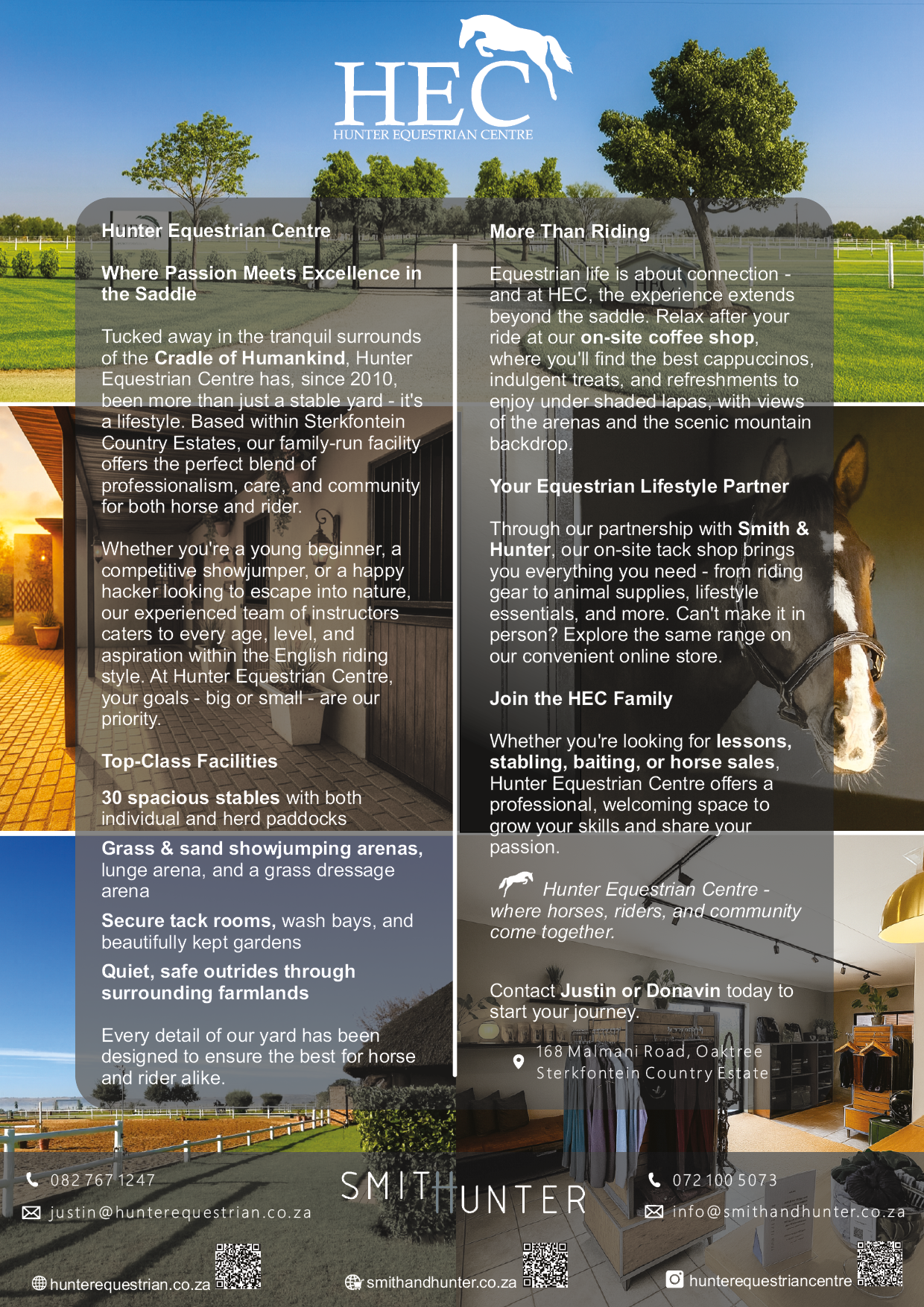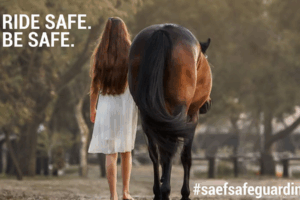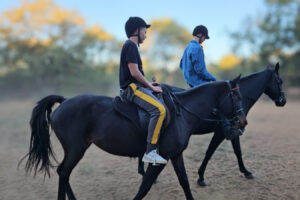There’s a unique silence that falls over the crowd just before a rider explodes down the track. A blur of muscle and speed, eyes locked on a tiny rectangular target half-buried in the earth. The horse gallops true, the rider lowers a lance, and with a precise lift, the peg comes free from the ground, mission accomplished. This is tentpegging, a cavalry sport reborn for the modern age.
Steeped in history and adrenaline, tentpegging is one of the most captivating disciplines in the equestrian world. It’s a thrilling test of speed, accuracy, and trust between horse and rider. While many might be unfamiliar with the sport, South Africa boasts a deep-rooted legacy in tentpegging and continues to shape its future both locally and on the global stage. And whether you’re an aspiring competitor or a curious spectator, there’s never been a better time to discover the art of the peg.
Equestrian Life chatted to Dalene Baksa, a veteran coach and passionate advocate for tentpegging, about the art and thrill of the sport and how South Africans have often led the sport on a global stage.
From battlefield to arena
Tentpegging traces its origins to the military manoeuvres of ancient cavalry forces. The name itself refers to the strategic wartime act of uprooting enemy tent pegs during a charge, destabilising camps and inciting chaos. Over centuries, this tactical manoeuvre evolved into a codified sport that honours the precision, courage, and horsemanship required by mounted warriors.
Today’s tentpegging is a far cry from battlefields, but it retains every ounce of intensity. Mounted riders gallop full speed while wielding a lance or sword, aiming to pierce and lift small ground targets (symbolic pegs), cut through suspended lemons, or remove rings suspended from overhead gallows. It’s a demanding discipline that requires supreme coordination, athleticism, and a deeply tuned connection between rider and horse.
And it is far more than just hitting the target—it’s about control and follow-through. Points are awarded based on how successfully the peg is removed and carried:
6 points – Carry: The peg is lifted cleanly and carried at least 10 metres or to the end of the course.
4 points – Draw: The peg is dislodged but falls before the 10-metre mark.
2 points – Strike: The peg is hit but remains in the ground—no lift.
Anything less than a clean carry may still earn points, but only a full carry guarantees maximum reward.
South Africa’s proud heritage
While the sport is popular in the Middle East and Asia, particularly in Pakistan and India, South Africa has built an equally rich tentpegging tradition. National Championships have been held here for more than 70 years, and the country has contributed significantly to shaping modern competitive formats.
“South African coaches have been instrumental in developing the sport globally,” says Dalene. “We’ve introduced disciplines like the sword and overhead items into the official programme, and our athletes continue to play a strong role on the international circuit.”
Dalene adds that South Africa hosted the fourth ITPF World Cup in 2023, a landmark event that showcased the country’s deep commitment to the sport. The fifth edition of the World Cup is set for 2026 and the honour of hosting has officially been awarded to the Hashemite Kingdom of Jordan.
The decision, confirmed by the General Assembly of the International Tent Pegging Federation in 2025, highlights Jordan’s capability to host world-class sporting events and is a major milestone for the region. South Africa, which won the inaugural World Cup in Egypt, remains a strong contender, even as international competition heats up with teams from Saudi Arabia, Pakistan, India, Egypt, Oman, and beyond.
What it takes to succeed
Tentpegging is not for the faint-hearted. Riders must display nerves of steel, razor-sharp focus, and exceptional hand-eye coordination. While experience counts, every competition demands adaptability, especially internationally, where riders must often compete on unfamiliar horses drawn at random.
“You need more than skill. You need mental toughness and a love for the horse,” says Dalene. “It’s not just about one good run. It’s about continuous improvement, resilience after mistakes, and always aiming for better.”
Technical ability is only one-half of the equation. The relationship between horse and rider is critical. Each movement, each split-second decision, depends on mutual trust and finely honed communication.
The unsung heroes, the horses of tentpegging
In the Middle East, Arabian horses are often the steed of choice, prized for their agility, stamina, and spirit. But in South Africa, a more tailored approach has emerged and riders often rely on crossbreeds, which include horses with the perfect balance of speed, steadiness, and responsiveness.
“It’s not about having the fanciest horse,” explains Dalene. “You want a horse with a calm temperament with the ability to accelerate fast, ideally covering 50 metres in around 4.3 seconds. Which really requires a special kind of animal.”
Tentpegging horses must remain relaxed under pressure yet switch gears instantly. The sport demands burst speed, absolute straightness, and the ability to stay focused despite loud crowds, flags, and unexpected distractions. If you know the horse and its fear of things that move and things that don’t move, it’s a unique ask and definitely not one that every horse can fulfil.
Training a horse for tentpegging involves conditioning, desensitisation to noise and movement, and building a bond of trust that allows riders to wield a weapon one-handed while galloping at full speed.
From clubs to championships
Dalene says that South Africa’s tentpegging scene is structured and inclusive. Each of the nine provinces has multiple clubs, where riders train and compete throughout the year. To qualify for National Championships, athletes must participate in at least four sanctioned competitions annually.
She says that training is rigorous, focusing on weapon handling, timing, course strategy, and mental preparedness. Riders also learn to adjust to different course setups, weather conditions, and even new horses, especially if they hope to compete abroad, where they aren’t able to take their own horses and will be required to ride unfamiliar mounts.
The annual SA Championships are a major highlight, attracting athletes of all ages and skill levels. It’s not just about the titles; it’s a celebration of the community and a breeding ground for future champions.
Nurturing the next generation
One of the sport’s standout qualities is its dedication to development. Local clubs and provincial associations run training camps, workshops and introductory events throughout the year, helping curious newcomers saddle up and give it a try.
At the heart of youth development is the Youth Festival. An innovative competition where young riders are placed into mixed teams and compete using a handicap system. This format encourages inclusivity and focuses on learning, improvement, and camaraderie.
“There’s a place for everyone,” says Dalene. “We’re not just building skills but also confidence, resilience, and passion. I’ve seen this sport transform young people positively.”
An international community
South Africa is a key member of the International Tentpegging Federation (ITPF), which now includes 50 member nations. Dalene mentions that the ITPF has its sights set on Olympic inclusion, with a proposed bid for Egypt to host tentpegging at a future Games.
South African athletes and coaches regularly travel for international events and training exchanges, ensuring the country stays at the forefront of innovation and performance. Despite increasing global competition, the local tentpegging community remains passionate, united, and ever-hopeful for another shot at a world title and maybe even Olympic gold.
Why tentpegging?
What makes tentpegging so compelling? Beyond the speed, precision, and spectacle is its blend of individual brilliance and team synergy. Dalene says riders can shine on their own, earning points for perfect runs, but there’s always a strong element of teamwork, whether in pairs, relays or full team items.
For Dalene, who has spent more than three decades coaching riders across South Africa, the appeal is undeniable. “This sport creates a sense of achievement you won’t find elsewhere,” she says. “You see riders grow, not just in ability, but in self-belief. It’s humbling, and it’s powerful.”
She encourages anyone with an interest in horses to attend a local event or get in touch with a club. “Come watch a competition. See the skill, the excitement, the sportsmanship. You’ll be surprised how quickly you’re drawn in.”
And now, with South Africa heading off to Iraq to qualify to compete at the 2026 World Cup in Jordan, now is the time to support and grow our talent. Whether from the grandstands or in the saddle, your involvement helps strengthen our legacy on the global stage.
Get involved
The doors are open. Whether you’re a rider, a coach, a parent, or a fan, South Africa’s tentpegging community welcomes you. Clubs across the country offer beginner lessons and regular clinics, and many events are free for spectators.
“You don’t need to start with a sword, just start with a visit. Witness the rhythm of hooves, the precision of a clean lift, and the pride of a team riding in unison. Tentpegging may have ancient roots, but its future is as dynamic and inclusive as the sport itself,” ends Dalene.
Off you go, head on to https://satentpegging.co.za
Know Your Event Formats
Tentpegging events are fast-paced, highly technical, and incredibly exciting to watch. Riders compete using either a lance or a sword, aiming to lift ground pegs or slice overhead objects, all within tight time limits. Here’s a breakdown of the most common international formats:
Individual Lance or Sword
One rider, one weapon, one run.
Riders gallop 70 metres to lift a 6cm-wide peg embedded in the ground at a 60° angle.
The peg must be carried at least 10 metres.
Time limit: 6.4 seconds.
Accuracy and clean movements are key—any deviation results in no score.
Pair Lance or Sword
Two riders ride side-by-side, each aiming for their own peg.
Run 1: 6cm peg.
Run 2: 4cm peg.
Time limit: 7 seconds.
Precision and synchronicity are essential. Missing your own peg or hitting the wrong one means zero points.
Team Lance or Sword
Four riders ride abreast.
Each must accurately lift their assigned peg correctly in three runs.
Run 1: 6cm peg.
Run 2 & 3: 4cm peg.
Time limit: 7 seconds per run.
A team can be penalised if even one rider hits the wrong peg.
Relay Lance or Sword
Four riders, riding one after another.
Pegs are placed 1.5 metres apart in a straight line.
Riders alternate:
Run 1: 6cm peg
Run 2: 4cm peg
Time limit: 10 seconds per run.
Speed, order, and accuracy across all four athletes is critical.
Overhead
Rings and Peg – Lance Item
One rider, one lance.
Riders must collect two rings suspended from overhead gallows followed by lifting a ground peg.
Rings: 5cm internal diameter, placed at 35m and 50m from the start, at 2.2m height.
Peg: 6cm, at 70m.
Time limit: 7 seconds.
Lemons and Peg – Sword Item
One rider, one sword.
Riders must slice two hanging lemons and lift a peg in a single run.
Lemons hang at 35m and 50m, at 2.2m height.
Peg: 6cm, at 70m.
Time limit: 7 seconds.
Technique matters
Cuts must be horizontal, not downward.
Right-handed riders:
- Lemon 1: right-to-left
- Lemon 2: left-to-right
Left-handed riders:
- Lemon 1: left-to-right
- Lemon 2: right-to-left
No points are awarded for downward cuts at the lemons or hitting them with the sword guard.

















